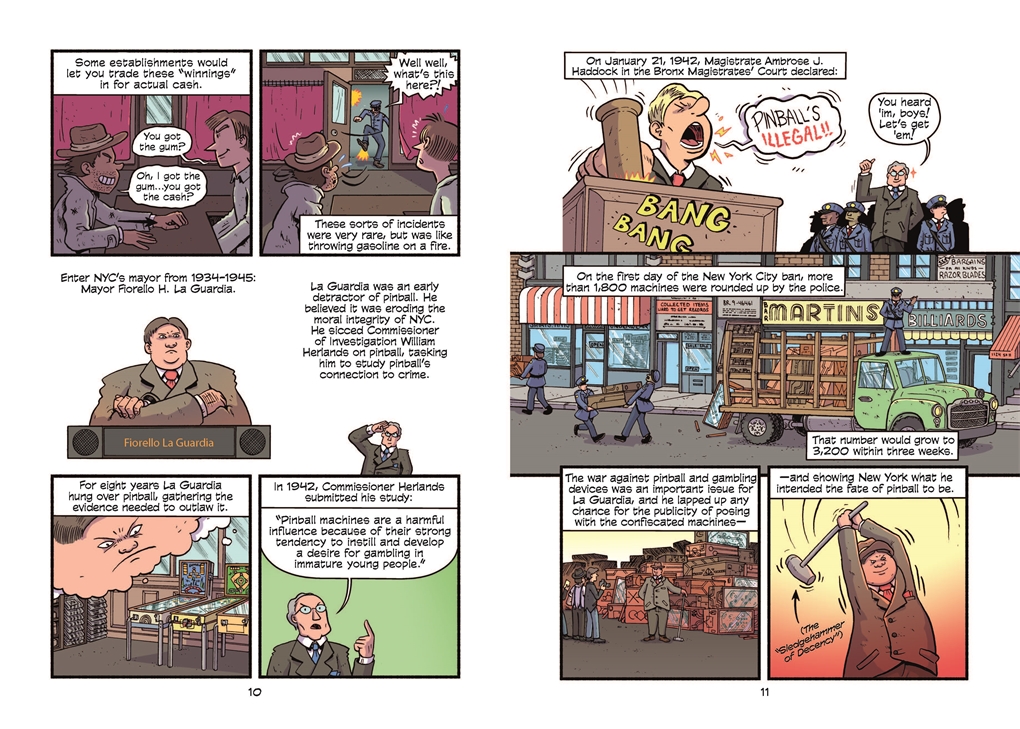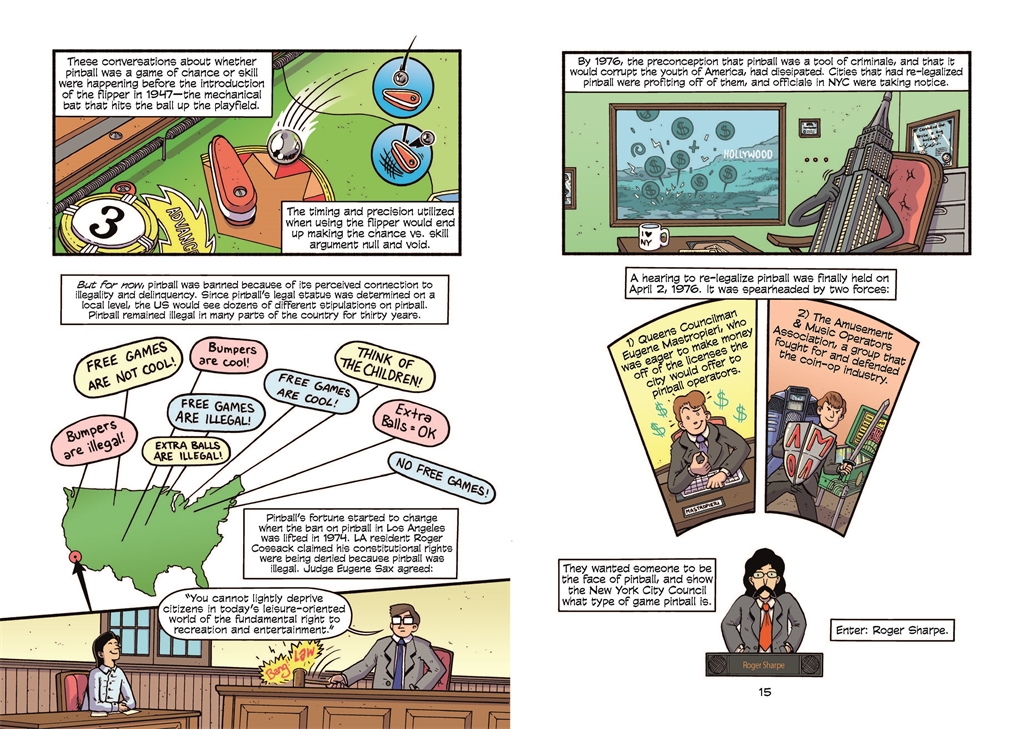One of the joys of comics is that you can make them about pretty much anything. It’s a field full of layabouts and obsessives, broad-ranging know-it-alls and ultra-specialized micro-experts; and because it features narrative and imagery, there’s no story you can’t tell and no history you can’t unfurl in a more or less engaging way. The difference between good and bad in the medium lies in the difference between those words “more” and “less”.
Lucky for Jon Chad – the very definition of an obsessive micro-expert, and a man who has been writing and drawing about pinball for decades – Pinball: A Graphic History of the Silver Ball is definitely on the more engaging side. I’d go as far to say that the book, a surprisingly deft combination of social history and how-to manual, is downright charming. Chad’s love for the noisy, electrified corner-bar classics permeates every page, skirting right up to the edge of being alienating but never quite getting there thanks to an infectious enthusiasm.
Of course, that’s easy for me to say. I’m one of those idiots who loves pinball. I spent most of my senior year of high school eschewing the lurid blinking pixels of 1942 and Pole Position in favor of shoveling quarter after quarter into Pin*Bot. While my friends got drunk at shows, I hung around in the back with my shoulders stooped over Funhouse. I worked shifts as a bartender proudly watching my wife play The Addams Family across the room. And even in the age of COVID, I snuck out to the Logan Arcade to try my hand at Pabst Can Crusher.
In other words, I’m exactly the kind of dork Pinball was written for. Casual pinball shooters, or non-fans, may not be engaged by Chad’s amusing and informative detailing of the history of the game, its many and baffling ‘controversies’, the development of its play from simple mechanical gravity-driven boards to high-tech animated wonders, or his lovingly fussy tips on strategy and tactics. But that’s not really the point, because the book isn’t for them. This is a comic for, well, enthusiasts, and if you happen to know one, this will be an easy sell. If you don’t, the book will be a curio not unlike the machines it so adores.
Visually, Pinball can be hit or miss. It’s very text-heavy and because it’s a comic and not an animated cartoon, it often tells rather than shows, and is weighed down by the generic lettering and captions that sometimes intrude on the art. On the other hand, Chad is a gifted caricaturist, which gives his figures lots of appeal, and his recreations of classic pinball machines is both comprehensive and engaging, giving the reader a real sense of why the game is so exciting in action. (This aspect is aided immeasurably by the aid of Luke Healy, one of my current favorite comics artists, with a color assist. The brightness and pop he brings to the book does more to sell readers on the thrill of the game than any text ever could.)
The sections where Chad offers tips and tricks on how to actually play the game of pinball are another example of material that will likely wow people who enjoy playing the silver ball but will bore those who don’t see the appeal. An exhaustive glossary, a terrific bibliography and list of references, and an interesting guide for novice players – all located at the end of the book – sent me down a rabbit hole of online investigation, and they made me wish I wasn’t in a snowbound metropolis in the middle of a pandemic so I could go find a machine and put his advice into practice. Casual readers, though, might find it all a bit mystifying.
That’s ironic, because much of the book is dedicated to the idea that pinball isn’t, as it’s still perceived to this day, a game of chance. Pinball fans all know and love the story of Roger C. Sharpe (prominently featured in Pinball), the man who proved to a New York court of law that it was a game of skill and ended a decades-long ban on the game because of its reputed association with organized crime. (Oddly enough, this forms a minor subplot in the current Paul Thomas Anderson film Licorice Pizza.) Sharpe’s legendary performance literally changed the game, physically and metaphorically.
I’d pick a few nits with Chad’s work as a historian. The absence of pachinko seems pretty glaring, and while Sharpe did indeed drive home his point with the force of a jammed plunger, it’s not entirely accurate to say that the association of pinball with organized crime was a baseless moral panic. (Here in Chicago, we know all too well about how the mob encouraged the proliferation of coin-operated machines because of their utility in money-laundering.) But he nicely captures how the game’s reputation was once highly unsavory; it’s a tragic tale that he manages to tell in a less grim fashion than the immortal trucking song “Pinball Machine” by the late, great Lonnie Irving. And whatever omissions or elisions exist in the book are overcome by its delightful energy and warmth.
Pinball: A Graphic History of the Silver Ball isn’t going to set the comics world on fire. It’s a niche guide to a niche game; it may not win many new converts to its subject; and while it fills a gap in addressing a topic that hasn’t had much attention paid to it in the medium, it may not be a gap that necessarily needed filling. But, like a great pinball machine, once you stop in somewhere and see it, you may just be drawn in by its craft, its sensory appeal, and its sense of fun. And if you’re like me and immediately got a frisson of joy at seeing a Bad Cats machine on the back cover, it’s a book you’ll never regret having on your shelf.










